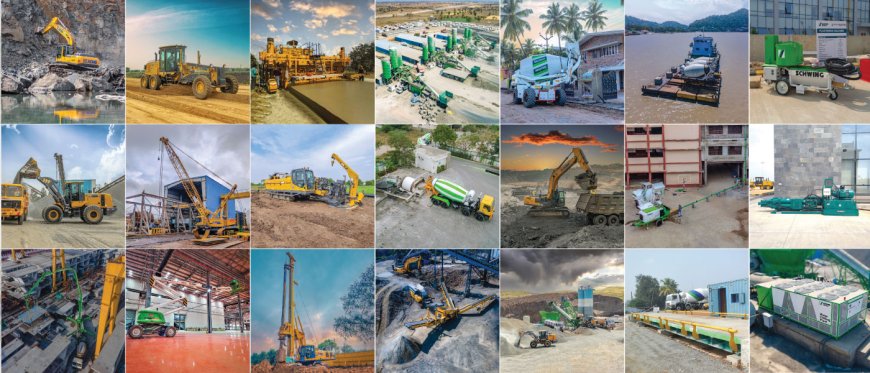BEHIND THE STRENGTH: How Concrete Machinery Redefines Construction
The market for concrete equipment is influenced by various factors like construction activity, infrastructure development, technological advancements, and environmental regulations. Equipment Times looks into the present state of the concrete equipment manufacturing sector, policies or regulations impacting manufacturing operations, recent

The market for concrete equipment is influenced by various factors like construction activity, infrastructure development, technological advancements, and environmental regulations. Equipment Times looks into the present state of the concrete equipment manufacturing sector, policies or regulations impacting manufacturing operations, recent standout features or innovations, quality control measures and standards, sustainability and reducing environmental impact and future plans or strategies for expansion or innovation in the concrete equipment manufacturing industry.
Governments worldwide continue to invest in infrastructure projects like roads, bridges, railways, and urban development. This drives the demand for concrete equipment such as mixers, pumps, and batching plants.
Rapid urbanization in many developing countries requires extensive construction, contributing to the demand for concrete equipment for residential and commercial buildings.
Innovations in concrete technology, including advanced mixing and pouring techniques, have led to the development of more efficient and sustainable equipment. Automation and IoT integration have also enhanced productivity and quality in concrete production.
Growing awareness of environmental impact has encouraged the use of sustainable materials and methods in construction. This trend has led to the development of eco-friendly concrete equipment that reduces waste and emissions. Fluctuations in global construction activity, influenced by economic conditions and government policies, can impact the demand for concrete equipment.
The maintenance and upgrade market for existing concrete equipment also play a significant role, offering opportunities for companies providing repair, maintenance, and modernization services.
It’s essential for companies in this sector to stay updated with technological advancements, adapt to changing environmental regulations, and consider expanding into emerging markets to sustain growth.
Innovations in the concrete equipment manufacturing industry…
The concrete equipment manufacturing industry has seen several innovations aimed at enhancing efficiency, sustainability, and safety.
Manufacturers have developed innovative mixing technologies to improve concrete quality and consistency. This includes twin-shaft mixers, planetary mixers, and continuous mixers that ensure better homogeneity and reduced mixing times.
Integration of automated batching systems and computerized controls has revolutionized concrete production. These systems ensure accurate material proportions, reducing waste and improving overall quality.
Innovations in materials have led to the development of sustainable or “green” concrete. This includes the use of supplementary cementitious materials like fly ash, slag, and recycled aggregates to reduce carbon footprint and promote eco-friendliness.
Advancements in precast concrete technologies have facilitated the manufacturing of complex and high-quality concrete elements off-site. This includes the use of robotics, 3D printing, and advanced formwork systems, resulting in faster construction and reduced on-site labor. Implementation of sensors and IoT devices in concrete equipment allows real-time monitoring of concrete properties such as strength, temperature, and moisture. This helps in better quality control and decision-making during construction. Manufacturers are focusing on designing equipment that is more energy-efficient and adaptable to various job site conditions. This includes equipment with lower emissions, improved fuel efficiency, and versatile features to handle different concrete mixes.
AR/VR applications are being used for training purposes, allowing operators to simulate equipment operation and troubleshoot issues without being on the actual job site. This enhances safety and reduces downtime.
There’s a trend towards remote operation and automation in concrete equipment. Remote-controlled machinery and automated processes improve safety by minimizing the need for human intervention in hazardous environments.
These innovations collectively aim to improve productivity, reduce environmental impact, enhance worker safety, and meet the evolving demands of the construction industry.
World of Concrete (WOC) in its 50th Year!
World of Concrete (WOC) is gearing up for its much anticipated 50th edition at the Las Vegas Convention Center (LVCC). Presented by Informa Markets, the annual event brings together the newest products, leading-industry suppliers, resources, and valuable education necessary for concrete and masonry professionals.
In 2023, WOC drew more than 48,000 registered professionals, with bustling foot traffic throughout the show, high engagement with the comprehensive educational offerings, and overall enthusiasm from participants, underscoring the industry’s critical need for in-person connections.
WOC 2024 will feature more than 1,200 exhibitors spanning more than 700,000 sq. ft. of indoor and outdoor exhibit and event space, as well as a world-class education program. This year’s show runs from January 23 to 25, with education sessions available starting on the 22nd.
The show is set to take place in the North, Central and South Halls of the Las Vegas Convention Center, as well as in the Silver and Bronze Lots for outdoor exhibits and events.
Central Hall is the place to check out material handling products, from trucks, excavators, paving equipment and more for material delivery, distribution, concrete placement, and earth moving, along with commercial construction concrete and masonry tools, and the ever-popular Work Truck LIVE!
Work Truck LIVE! highlights innovations in the design and configuration of work trucks as well as innovative accessories that will help contractors increase safety and productivity.
Concrete producers, and contractors looking for information about construction technology, precast products, concrete masonry and concrete reinforcement will be well served by the demonstrations, products and services on display in the North Hall.
In addition to all things masonry, the South Hall in the LVCC will also feature concrete repair and demolition, and surface and decorative products, including the latest in surface preparation equipment, scarifying, grinding, sawing equipment, sealants, joint fillers, coatings, and cleaning solutions. The outdoor areas, in the Silver Lot and Bronze Lot, will feature live demos and heavy equipment, as well as championships, skills challenges and demos.
Starting a day before the exhibits open, the 2024 World of Concrete Education Program will offer a variety of in-depth learning options for concrete and masonry professionals covering such topics as technical applications, business best practices, project management, and safety-relevant topics for every skill level from beginner to experienced. World of Concrete has been serving the global concrete & masonry construction industries for 50 years. We connect and educate buyers and sellers through live and digital events throughout the year, facilitated via worldofconcrete.com, and WOC360. Our goal is to provide this important community with the connections, intelligence, and opportunities that help customers grow, do business, and make better informed business decisions.
Original equipment manufacturers from around the world and exclusive U.S. distributors of equipment, tools, products and services for the commercial construction, concrete and masonry industries.
Technological advancements in Concrete Equipment…
Concrete equipment has seen significant technological advancements aimed at improving efficiency, precision, and sustainability in construction. Here are some notable advancements:
Self-Consolidating Concrete (SCC): This type of concrete flows easily into place, filling complex forms without the need for vibration. It allows for faster construction and minimizes the need for manual labor.
Advanced Mix Design: Concrete mix designs have evolved with the use of additives and admixtures that enhance strength, durability, and workability. These additives can improve concrete’s resistance to cracking, increase curing time, and reduce water content.
High-Performance Concrete (HPC): HPC is designed to withstand higher compressive forces, making it ideal for demanding structures like bridges and skyscrapers. Its development involves precise control of the mix constituents and curing conditions.
3D Concrete Printing: This technology enables the construction of intricate structures by depositing concrete layer by layer according to a digital model. It’s being explored for its potential in creating complex architectural designs quickly and with less material waste.
Fiber-Reinforced Concrete: Adding fibers, such as steel, glass, or synthetic materials, to concrete enhances its tensile strength
and controls cracking. This makes the concrete more durable and suitable for various applications.
Advanced Concrete Pumping Systems: Pumping systems have become more sophisticated, allowing for precise placement of concrete at varying heights and distances. Boom pumps and specialized delivery systems facilitate efficient concrete placement.
Smart Concrete Sensors: Sensors embedded in concrete structures provide real-time data on temperature, moisture, stress, and strain. This information helps in monitoring the health of structures and predicting maintenance needs.
Carbon Capture in Concrete: Researchers are exploring ways to capture and store carbon dioxide emissions within concrete materials, making them more environmentally friendly.
Nanotechnology in Concrete: Nanoparticles are being used to modify the properties of concrete, enhancing strength, durability, and even self-healing capabilities.
Electric and Hybrid Construction Equipment: Electric or hybrid machinery for mixing, pumping, and placing concrete is gaining traction, reducing emissions and noise on construction sites.
These advancements collectively aim to improve the quality, sustainability, and efficiency of concrete construction, addressing various challenges in the industry.
Challenges in the sector…
The concrete equipment industry faces several challenges that impact its operations and growth. Some of these challenges include:
Technological advancements: Keeping up with technological innovations and integrating them into concrete equipment to improve efficiency, safety, and environmental sustainability can be demanding and costly.
Regulatory compliance: Meeting and adapting to evolving environmental regulations, safety standards, and industry codes can be challenging. Compliance often requires continuous updates to equipment and processes.
Environmental impact: Concrete production and equipment operations can have a significant environmental footprint due to energy consumption, emissions, and waste generation. Finding more sustainable practices and materials is an ongoing challenge.
Maintenance and downtime: Ensuring equipment reliability and minimizing downtime due to maintenance or unexpected breakdowns is crucial. Finding ways to optimize equipment uptime without compromising safety or quality is a constant concern.
Cost pressures: Cost fluctuations in raw materials, energy, labor, and transportation can impact profitability. Balancing cost-efficiency with quality standards and technological upgrades can be challenging.
Global competition: The concrete equipment industry faces competition from both domestic and international manufacturers. Staying competitive requires innovation, quality products, efficient processes, and sometimes aggressive pricing strategies.
Skills and labor shortages: Skilled labor shortages and the need for specialized training for operating and maintaining advanced equipment can pose challenges. Recruiting and retaining skilled workers can be difficult.
Market demand fluctuations: The industry is susceptible to economic fluctuations, affecting construction and infrastructure projects, which, in turn, impacts the demand for concrete equipment.
Supply chain disruptions: Disruptions in the supply chain, whether due to natural disasters, geopolitical tensions, or other factors, can impact the timely delivery of components and materials required for manufacturing concrete equipment.
Adoption of new practices: Encouraging the adoption of new technologies or practices within the industry can be slow due to established norms, resistance to change, or uncertainty about the benefits of adopting new methods.
Addressing these challenges often involves a combination of innovation, collaboration, investment in research and development, regulatory compliance, and a proactive approach to changing market dynamics.
Leaders speak…

V. G. Sakthikumar, Chairman and Managing Director, Schwing Stetter India, said, “The concrete equipment manufacturing industry in India is currently in a dynamic and resilient state, having adeptly navigated challenges posed by the COVID-19 pandemic and subsequent economic recovery. The sector is witnessing growth with increased demand in key areas such as infrastructure, mining, and shipping, fueled by substantial investments from both government and private entities. Notably, there’s a notable commitment to innovation, sustainability, and customer satisfaction demonstrated through the launch of new products and solutions tailored to the evolving market needs.”

V. Senthilkumar, Managing Director, Propel Industries, said, “Launched with significant enthusiasm, the “Make in India” initiative set ambitious targets for the government, including increasing manufacturing growth by 12-14% per annum, elevating the share of manufacturing in the GDP to 25% by 2022, and generating 100 million jobs in the manufacturing sector by 2022. These goals have profoundly influenced our manufacturing operations.
Government policies and regulations play a pivotal role in shaping our strategies, and we actively align with and adhere to regulatory frameworks. Initiatives like “Make in India” have provided a substantial impetus to local manufacturing, creating a conducive environment that facilitates and enhances our operations. This commitment not only contributes to the realization of national objectives but also reinforces our dedication to fostering indigenous manufacturing capabilities.”

Kalpesh Soni, Vice President – Marketing, KYB Conmat, said, “With heavy focus on R&D backed with strong market research, it enables us to understand the needs of our customers better and serve them with the best products in the market through sustained innovations and improved manufacturing processes.
This includes the use of eco-friendly materials and reducing our carbon footprint in the manufacturing process. For example, Our Self-Loading Concrete Mixers machines are IOT enabled, BS-4 and ARAI compliant, offering better fuel efficiency. We make our machines as per latest standards of the emission control and aggressively work towards making our machine more environmentally sustainable in the process.”
Hits: 24








